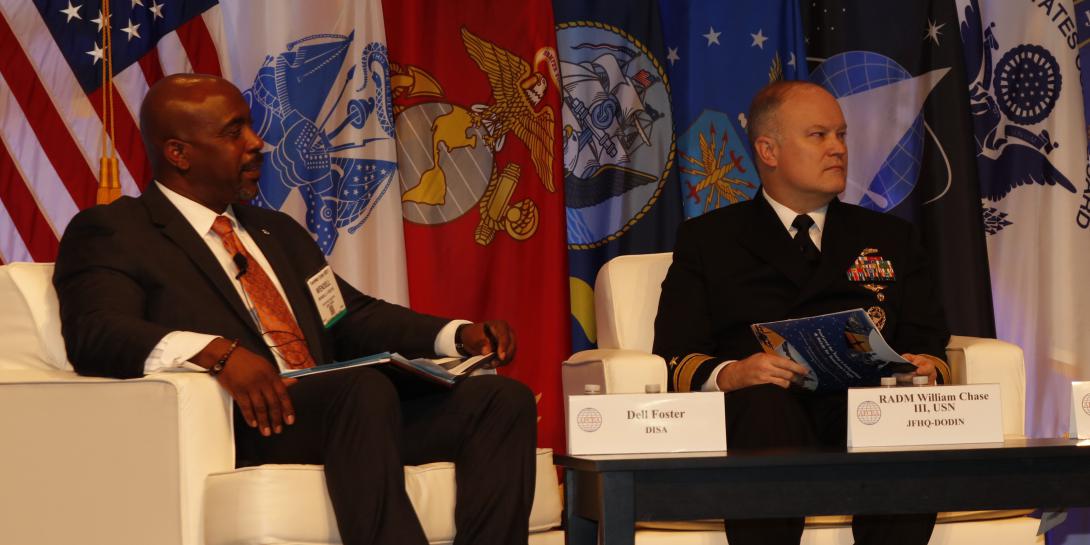Fast Pivots Will Drive Cybersecurity Success
To be prepared for today’s cyberspace competition and ready for tomorrow’s fight requires a new, comprehensive look at strategic focus areas within the Joint Force Headquarters-Department of Defense Information Network (JFHQ-DODIN). Those focus areas include streamlining command and control; organizing battle space; optimizing technology; harnessing the power of partnerships; and cultivating change and talent management.
Agility and velocity are important in support of these strategies, so the challenge is how to ensure the presence of both in a continuously competitive environment like cyberspace. Rear Adm. William E. Chase III, USN, deputy commander, JFHQ-DODIN, and Wendell E. Foster Jr., executive director, DODIN, recently discussed the strategies JFHQ-DODIN will use for the 45 organizations it supports. These organizations include all the services as well as defense agencies.
Participating at AFCEA International’s TechNet Cyber in Baltimore October 27-28, the two JFHQ-DODIN leaders spoke on a variety of topics relevant to the strategies, including having the ability to know the entirety of the terrain, applying automation in the right ways, building in cyber situational awareness, addressing data analysis and distribution, optimizing the technology and the support of partners, developing a mature cyber workforce, and the role of agility and velocity.
Agility and velocity do not only come from tools. You have to have the people and process as well, Foster said. “Get the human out of loop so we can get humans doing things that only humans can do. We cannot out-manpower this issue, so we need to be better at automation, and advances in artificial intelligence and machine learning need to take place as well. We have to bake in operational considerations from start to finish,” Foster explained.
The increase in malware and supply chain attacks is creating the “arms race of our time in cyberspace, so do we posture for that not knowing what’s coming? It is best if you can know what is coming and what is being weaponized,” explained Adm. Chase. It starts with making sure partnerships are in place for great intelligence community intel as well as commercial threat intel so the country can pivot to next step.
“The crux of agility and velocity has to do with cyber situational awareness—our ability to see. Can we see ourselves, our forces, our terrain? Can we maneuver and respond to intrusions quickly; are we being proactive; do we know our adversary; and can we respond to threats?” he elaborated.
“We want preplanned response for certain things we know are coming even if we don’t know where they are. We want to turn these into preplanned response, which speaks to a lot of the agility and making sure we move with velocity, have a direction and know where we are moving next,” explained Adm. Chase.
Agility and velocity are also important within Joint All-Domain Command and Control (JADC2), which is founded around the idea of commanders making decisions and having what they need to make the right decision.
JADC2 must enable visualization of the terrain in the battlefield so commanders can make timely and appropriate decisions. There must be the right sensors end to end and at the tip. It must be known what questions the commander wants to answer, what data must be collected to answer those questions and how the analytics will question the data. This looks like a big data problem, Adm. Chase suggested, but added it is less about the data itself. Data is important, but what is really important is getting the data flow to commanders who need it when they need it.
From meeting the goals of JADC2 to ensuring the successful implementation of JFQH-DODIN strategies, workforce management is foundational. Foster addressed this, stressing the need to hire people who understand technical side of cyberspace operations as well as warfighting and joint planning. “On flip side,” he explained, “to recruit and retain a good civilian work force, we need to partner with academia. We need to make sure they understand the difference between information technology management, cybersecurity and cyber operations as we see it at the DoD.” This, he added, will take a combination of patience, military school influence and work with civilian partners.
The military will have to provide meaningful work Adm. Chase emphasized, which involves removing bureaucracy and defining work roles. “People need to come away with a sense of satisfaction,” he added.





Comments